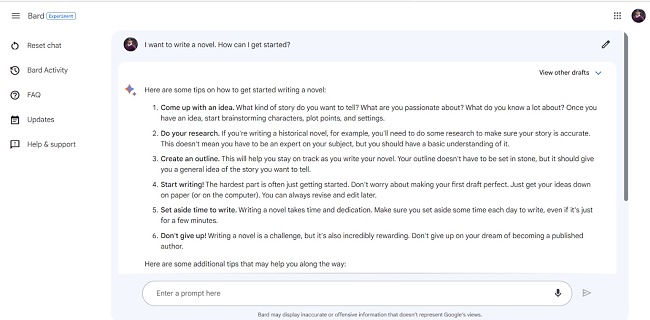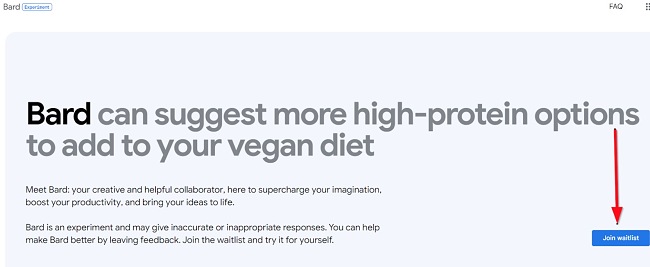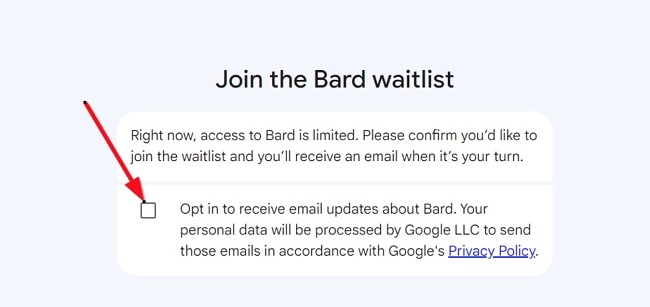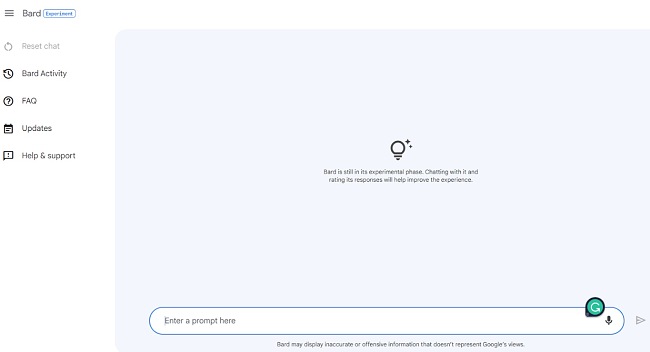Google Bard Download for Free - 2024 Latest Version
Google Bard is an AI chatbot that answers your questions directly instead of listing web pages to visit. Shifting from the regular search engine model and embracing conversational AI, Bard has been designed to instantly summarize texts and generate useful content for anyone looking for answers on different topics. The tool was introduced in the UK and the U.S. in March 2023, and you must be over 18 to use it.
Google Bard is free. You can access it from the official Bard website in your web browser. Follow the guide below, and I’ll show you how to get started.
How to Register and Start Using Google Bard on Your PC for Free
- Click the download button on the sidebar to go directly to the Google Bard page.
- Click the “Join waitlist” button to request access to the tool.
![Google Bard join waitlist screenshot]()
- Check the box on the next page to register your interest. You will receive an email acknowledging your registration. To use Bard, you need a personal Google Account that you manage on your own. It should not be managed by a parent, guardian, or Google Workspace admin — plus, you must be 18 or older.
![Google Bard opt-in screenshot]()
- Check your email to know when you’ve been given access to try Google Bard.
Once you have access, enter your prompts or questions in the chat space provided and hit Enter.
![Google Bard user interface screenshot]()
How to delete your Google Bard account
Bard is a web app and does not require any installation or uninstallation. Since you only need your Google account to join the waitlist or sign in to Google Bard, you do not need to do anything else if you wish to stop using the service.
If you would like to try other similar AI Chatbots, check out the free alternatives below.
Overview of Google Bard
Google Bard is a conversational AI tool based on Google’s LaMDA (Language Model for Dialogue Applications), introduced back in 2021. Although Bard is still very much experimental, it uses the LaMDA technology to allow you to collaborate with generative AI. The LaMDA language model was trained on trillions of words to help it understand human language and give you reasonable responses.

In essence, Bard serves as a creative collaborator, helping you with ideation, enhancing your creativity, and boosting your productivity. For example, Bard can help you draft an invitation, write an email copy, create a pro and con list for making a big decision, or brainstorm ideas for your birthday party. The tool also features a “Google It” button, so you can easily move from Bard to the web for more information. As good as it sounds, Bard has some limitations.
Sometimes, Bard can give you inaccurate responses. To improve this, a “thumbs down” button is included so that you can provide your feedback. Unlike Chat GPT, Bard is currently unable to help you with coding. Bard has a limited ability to hold context during more extended conversations. This means that its ability to know what you said earlier in a conversation is limited. Language support is also abysmal, as right now, Bard is available only in US English and a handful of countries.
How Does Bard Work?
1. Bard is powered by LaMDA: LaMDA is a machine learning technology trained on a large dataset (consisting of public dialogue and web data) that enables it to identify and understand patterns that characterize human language and interaction. Bard is powered by a lightweight model version of LaMDA, allowing the chatbot to engage seamlessly with you on various topics.
2. Bard scans the internet: Google Bard is directly connected to the web, so you need an active internet to connect to use the tool. The chatbot scans the internet to learn words, phrases, and ideas associated with your query. Unlike Chat GPT, Bard has access to the web, allowing it to provide fresh, up-to-date information. The tool uses a conversational tone in its responses. Note that Bard is different from Google Search. Unlike Google Search, its interactive model allows you to explore different topics.
3. Bard uses your data to improve efficiency: When interacting with Bard, Google collects your conversations, location (based on your IP address), feedback, and usage information. Google uses this data to improve its machine-learning technologies, including Bard and other Google products and services. Bard uses your general location and past conversations to generate better responses. It removes conversations reported as being low quality.
While Google has access to your conversations with Bard, it maintains that it is only for review and improvement purposes and not for advertisement while keeping your privacy intact.
Features of Google Bard
- Context-specific responses during conversations.
- Ideal for intelligent and creative collaborations during essential writing tasks.
- Gather data from online sources and customer feedback to give the best responses.
- Original, non-plagiarized answers.
- Available only in US English, but Google intends to include as many languages as possible soon.
- Responds to both simple and complex questions on any subject.
New Features in Google Bard
Export to Google Docs and Gmail: You can easily export content from Bard to Google Docs or Gmail. Tap the button at the bottom of Bard’s response to export and edit directly in Workspace apps.
Use Bard with Your Workspace Account: Use Bard at work to execute business tasks. Simply sign into your Google Workspace account. Your account admin may need to enable access to this.
Dark Theme: If you choose a dark theme for your OS setting, Bard can adapt as well. You can also turn it on directly in Bard from the menu.
Collaborate in Japanese & Korean: Bard has introduced two additional languages alongside English. Google’s goal is to further extend worldwide language options, even as Bard is presently accessible in more than 180 countries.
Free Alternatives to Google Bard
ChatGPT: ChatGPT is arguably the top alternative model to Google Bard because of its impressive features. It is available for free to everyone. But, it has introduced a paid plan, ChatGPT Plus, that gives you access to GPT-4 and other advanced features.
Bing AI Chat: Bing Chat, otherwise known as Bing with ChatGPT, is a conversational AI tool deployed by Microsoft to help people get direct, summarized answers to queries across all topics. However, unlike Google Bard, Bing Chat doesn’t seem to use any fixed dataset curated by its creators. Instead, it gathers answers from the web and provides references to support its responses.
WriteSonic Chatbot: Writesonic is an AI-powered chatbot that provides up-to-date factual information using Google’s knowledge graph. It is designed to beat the limitations of ChatGPT. Writesonic focuses mainly on creating and manipulating content, such as writing articles and summaries.







